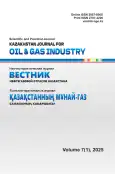The role of Capillary Hysteresis in Enhancing CO₂ Trapping Efficiency and Storage Stability
- Authors: Khoramian R.1, Pourafshary P.1, Riazi M.1
-
Affiliations:
- School of Mining and Geosciences, Nazarbayev University
- Issue: Vol 7, No 1 (2025)
- Pages: 90-99
- Section: PHYSICO-CHEMICAL AND MICROBIOLOGICAL STUDIES
- URL: https://journal-vniispk.ru/2707-4226/article/view/293588
- DOI: https://doi.org/10.54859/kjogi108781
- ID: 293588
Cite item
Full Text
Abstract
Background: The intensifying impact of climate change demands innovative approaches to reduce atmospheric CO₂ levels. Carbon Capture and Storage (CCS) offers a viable solution by sequestering CO₂ in geological reservoirs. However, understanding the role of capillary hysteresis in CO₂ trapping is critical for optimizing CCS performance.
Aim: This study aims to investigate the influence of capillary hysteresis on CO₂ trapping efficiency in saline aquifers using detailed simulation models and varying hysteresis values.
Materials and methods: Advanced CMG simulation software was utilized to model CO₂ injection and migration in saline aquifers spanning depths of 1200–1300 meters. The model, initially saturated with brine, applied water-alternating-gas (WAG) injection at hysteresis values of 0.2, 0.3, 0.4, and 0.5 to evaluate their effect on CO₂ trapping efficiency.
Results: The simulations demonstrated a direct positive correlation between hysteresis values and CO₂ trapping efficiency. At a hysteresis value of 0.5, nearly 100% CO₂ trapping was achieved. This increased efficiency was attributed to stronger capillary forces immobilizing CO₂ more effectively and reducing mobility towards caprock, thereby minimizing leakage risks.
Conclusion: The study highlights the key role of capillary hysteresis in enhancing CO₂ sequestration. Higher hysteresis values improve long-term storage stability, emphasizing the need for optimized WAG injection strategies in CCS applications.
Full Text
##article.viewOnOriginalSite##About the authors
Reza Khoramian
School of Mining and Geosciences, Nazarbayev University
Email: reza.khoramian@nu.edu.kz
ORCID iD: 0009-0008-7775-3816
Kazakhstan, Astana
Peyman Pourafshary
School of Mining and Geosciences, Nazarbayev University
Author for correspondence.
Email: peyman.pourafshary@nu.edu.kz
ORCID iD: 0000-0003-4600-6670
Professor
Kazakhstan, AstanaMasoud Riazi
School of Mining and Geosciences, Nazarbayev University
Email: masoud.riazi@nu.edu.kz
ORCID iD: 0000-0002-6843-621X
Associate Professor
Kazakhstan, AstanaReferences
- Sarkodie SA, Owusu PA, Leirvik T. Global effect of urban sprawl, industrialization, trade, and economic development on carbon dioxide emissions. Environmental Research Letters. 2020;15(3):034049. doi: 10.1088/1748-9326/ab7640.
- Mishra RK, Dubey SC. Solar activity cause and effect of climate variability and their various impacts. British Journal of Multidisciplinary and Advanced Studies. 2023;4(2):21–38. doi: 10.37745/bjmas.2022.0133.
- Kelemen P, Benson SM, Pilorgé H, et al. An overview of the status and challenges of CO₂ storage in minerals and geological formations. Frontiers in Climate. 2019;1:482595. doi: 10.3389/fclim.2019.00009.
- Ilavya A, Patel K, Bera A. Chapter Two – Underground carbon storage. In: Rahimpour MR, Makarem MA, Meshksar M, editors. Advances and Technology Development in Greenhouse Gases: Emission, Capture and Conversion. Greenhouse Gases Storage and Transportation. Elsevier; 2024. P. 25–44.
- Iglauer S. Optimum storage depths for structural CO₂ trapping. International Journal of Greenhouse Gas Control. 2018;77:82–87. doi: 10.1016/j.ijggc.2018.07.009.
- Moghadasi R, Goodarzi S, Zhang Y, et al. Pore-scale characterization of residual gas remobilization in CO₂ geological storage. Advances in Water Resources. 2023;179:104499. doi: 10.1016/j.advwatres.2023.104499.
- Bashir A, Ali M, Patil S, et al. Comprehensive review of CO₂ geological storage: Exploring principles, mechanisms, and prospects. Earth-Science Reviews. 2024;249:104672. doi: 10.1016/j.earscirev.2023.104672.
- Sasowsky ID, White WB, Webb JA. Acid mine drainage in karst terranes: geochemical considerations and field observations. In: Beck BF, editor. Karst Geohazards. London: Routledge; 1995. P. 241–247.
- Burnside NM, Naylor M. Review, and implications of relative permeability of CO₂/brine systems and residual trapping of CO₂. International Journal of greenhouse gas control. 2014;23:1–11. doi: 10.1016/j.ijggc.2014.01.013.
- Sedaghatinasab R, Kord S, Moghadasi J, Soleymanzadeh A. Relative permeability hysteresis and capillary trapping during CO₂ EOR and sequestration. International Journal of Greenhouse Gas Control. 2021;106:103262. doi: 10.1016/j.ijggc.2021.103262.
- Zapata Y, Kristensen MR, Huerta N, et al. CO₂ geological storage: Critical insights on plume dynamics and storage efficiency during long-term injection and post-injection periods. Journal of Natural Gas Science and Engineering. 2020;83:103542. doi: 10.1016/j.jngse.2020.103542.
- Edlmann K, Hinchliffe S, Heinemann N, et al. Cyclic CO₂–H₂O injection and residual trapping: implications for CO₂ injection efficiency and storage security. International Journal of Greenhouse Gas Control. 2019;80:1–9. doi: 10.1016/j.ijggc.2018.11.009.
- Shaw D, Mostaghimi P, Armstrong RT. The dynamic behavior of coal relative permeability curves. Fuel. 2019;253:293–304. doi: 10.1016/j.fuel.2019.04.107.
Supplementary files
















